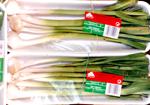| Fruits |
Vegetables
|
Garlic, Alium sativum / Liliaceae (Alliaceae)
Postharvest Atmosphere Management

The first process after harvesting consists of drying or curing the garlic, in order to dry the external part. It is possible to do so in the field: the plants are collected whole and left in the field for 5 to 10 days. The drying ends in the warehouse. Another type of system is to take the bulbs immediately to the warehouse, where all the drying is carried out. Ventilation must be forced at the beginning, until the garlic looses from 20 to 25% of its initial weight.
The garlic preservation depends on the condition of the produce (healthiness, climate, etc). At environmental temperature they can be preserved for short periods, whereas in order to extend storage it is necessary to use store rooms, where it is possible to control the moisture and the temperature. It is also important to have a good ventilation to finish the drying, if necessary. At present, the garlic is stored in pallets, that must allow the air circulation through the produce.
The satisfactory conditions for garlic storage are temperatures of 0 to 1ºC, and around 70% of moisture, enabling them to be preserved up to 6-8 months. Good results have been observed if they are stored at -2ºC.
Apart from cold storage, the garlic bears storage at high temperatures, extending the period of preservation. For that purpose, the temperature must be kept around 18-19ºC, at 70% of relative humidity. In this way, garlic may be stored for 3 months, although by means of this system the loss of weight is greater than with cold storage.
The garlic preservation depends on the condition of the produce (healthiness, climate, etc). At environmental temperature they can be preserved for short periods, whereas in order to extend storage it is necessary to use store rooms, where it is possible to control the moisture and the temperature. It is also important to have a good ventilation to finish the drying, if necessary. At present, the garlic is stored in pallets, that must allow the air circulation through the produce.
The satisfactory conditions for garlic storage are temperatures of 0 to 1ºC, and around 70% of moisture, enabling them to be preserved up to 6-8 months. Good results have been observed if they are stored at -2ºC.
Apart from cold storage, the garlic bears storage at high temperatures, extending the period of preservation. For that purpose, the temperature must be kept around 18-19ºC, at 70% of relative humidity. In this way, garlic may be stored for 3 months, although by means of this system the loss of weight is greater than with cold storage.
Distribution
The garlic must be transported alone, since it gives off unpleasant smells to the produce with which it is stored or transported. The levels of moisture must be optimal, around 70%, specially if it is a long trip.
The distribution must be carried out at environmental temperature, under low levels of humidity and strong ventilation.
The distribution must be carried out at environmental temperature, under low levels of humidity and strong ventilation.
Postharvest Problems
The garlic may undergo several problems during its storage, such as bud sprouting and fork developing, diseases like blue rot or soft rot, and the attack of determined pests, being insect larvae or acari.
The development of buds and roots may occur, 2 or 3 months after the harvesting. At the beginning it is a very slow process, although after some time it speeds. Temperatures between 5 and 10ºC favour the sprouting, whereas the inferior and superior temperatures inhibit it. The high levels of moisture also facilitate this problem, although if they are too low, the bulb dehydrates.
The development of buds and roots may occur, 2 or 3 months after the harvesting. At the beginning it is a very slow process, although after some time it speeds. Temperatures between 5 and 10ºC favour the sprouting, whereas the inferior and superior temperatures inhibit it. The high levels of moisture also facilitate this problem, although if they are too low, the bulb dehydrates.
| Interempresas Media, S.L. / 2026 | [ Legal notice | Política de Protección de Datos | Política de cookies | Publicidad] |
